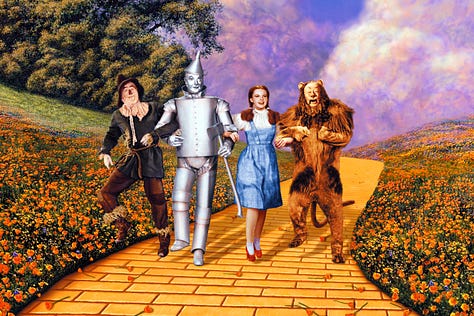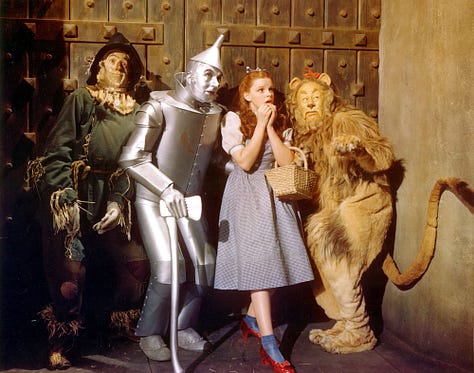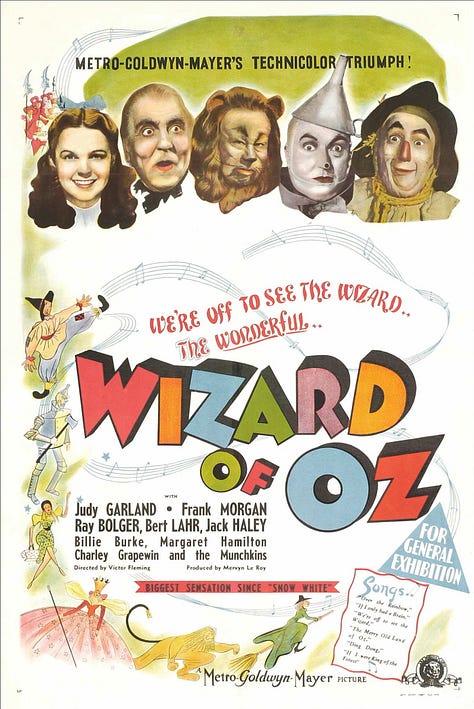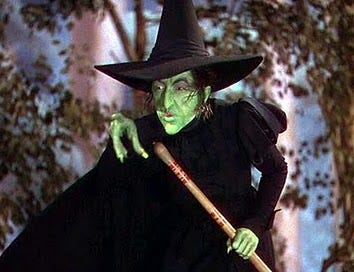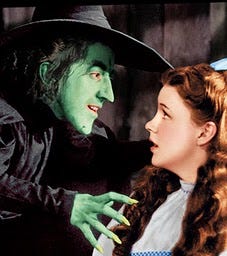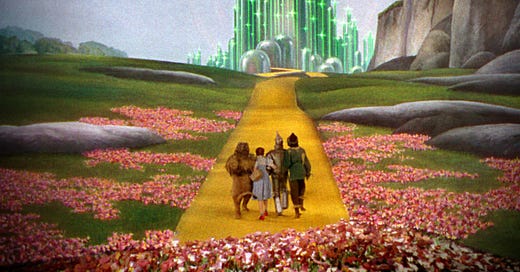THE WIZARD OF OZ
1939 • Victor FlemingCast: Judy Garland, Frank Morgan, Ray Bolger, Bert Lahr, Jack Haley, Billie Burke, Margaret Hamilton, Charley Grapewin, Pat Walshe, Clara Blandick
Screenplay: Noel Langley, Florence Ryerson, Edgar Allan Woolf; Based on The Wonderful Wizard of Oz by L. Frank Baum
Cinematography: Harold Rosson
Music: Herbert Stothart
Producer: Mervyn LeRoy
Metro-Goldwyn-Mayer
I'll get you, my pretty, and your little dog, too!
I usually start these entries with a plot synopsis, but I mean who hasn’t seen The Wizard of Oz? As an immigrant, I can confirm that you are given a VHS copy when you become a citizen. That’s true. Don’t look it up. The Wizard of Oz is a timeless classic that follows the enchanting journey of Dorothy Gale, a spirited young girl from Kansas, as she is swept away to the magical land of Oz in a tornado. When Dorothy lands in the fantastical world, she discovers that her house has unintentionally squashed the Wicked Witch of the East, earning her the gratitude of the Munchkins and a pair of magical ruby slippers. However, the Wicked Witch of the West is a little miffed that Dorothy killed her sister, and she vows revenge. Desperate to return home, Dorothy sets out on the Yellow Brick Road to seek the help of the Wizard of Oz in the Emerald City. Along the way, she is joined by three unlikely companions: the Scarecrow, who longs for a brain, the Tin Man, who wishes for a heart, and the Cowardly Lion, in need of courage. The four become fast friends and embark on one of the most wondrous adventures in cinema.
One of the key reasons for Oz’s pervasive presence in pop culture is its universal themes. The journey of Dorothy, the Scarecrow, the Tin Man, and the Cowardly Lion resonates with audiences of all ages, and the lessons learned along the Yellow Brick Road are timeless. The quest for brains, heart, and courage, as well as the ultimate realization that what we seek is often within ourselves, are enduring messages that continue to inspire countless stories and characters in literature, film, and television. The characters themselves have become iconic symbols. Dorothy's ruby slippers, the Scarecrow's quest for a brain, the Tin Man's longing for a heart, and the Cowardly Lion's journey toward courage are not just narrative elements but cultural touchstones. These characters have been reimagined, parodied, and referenced in countless forms of media, solidifying their places in the collective consciousness.
Musically, The Wizard of Oz boasts one of the most enduring and recognizable soundtracks in film history. "Over the Rainbow," sung by Judy Garland as Dorothy, is a cultural anthem that has been covered by countless artists and used in diverse contexts, further embedding itself into the fabric of popular culture. Composed by Harold Arlen with lyrics by E.Y. Harburg, the song is as American as apple pie. Judy Garland's heartfelt rendition captures the essence of longing and aspiration. The song is an expression of Dorothy's desire for a place where dreams come true, far away from the challenges of sepia-toned reality. The song's enduring appeal lies not only in its association with the film but also in its ability to evoke a wide range of emotions. Its themes of hope, yearning, and the quest for a better life have made it a go-to choice for artists across genres and generations. Lyrics like "Somewhere over the rainbow, skies are blue, and the dreams that you dare to dream really do come true," have provided solace and inspiration to individuals facing challenges, turning it into a symbol of optimism and perseverance.
The film's impact on language is also noteworthy. Only surpassed in quotably by Casablanca, The Wizard of Oz gave us phrases that we use in our everyday lexicon: There's no place like home." Dorothy's realization at the end of her adventure has become a universal expression of comfort and belonging. It is often used to convey the sentiment that one's true home is where the heart is. "Follow the Yellow Brick Road." This phrase, uttered by Glinda the Good Witch, has become a metaphor for embarking on a journey or seeking guidance. It is often used to encourage someone to find their path or navigate through challenges. "Lions and tigers and bears, oh my!" This is playfully used to express apprehension or exaggerate fears about a situation. "Pay no attention to the man behind the curtain!" The Wizard's desperate plea to distract from his true identity has become a metaphor for revealing the truth behind a façade or deception. "I'll get you, my pretty, and your little dog too!" The Wicked Witch of the West's menacing threat has become a memorable expression of impending doom or retaliation, often used in comedic contexts. "We're not in Kansas anymore." Dorothy's observation upon entering the colorful world of Oz is commonly used to express the feeling of being in an unfamiliar or surreal situation. "Ding-dong, the witch is dead!" The jubilant Munchkins' victory cheer has become a celebratory expression for the downfall of a particularly loathsome person.
There are few films as beautiful or visually lavish as The Wizard of Oz. The film's cinematography, particularly the transition from black-and-white to Technicolor, is unforgettable. The decision to film the opening scenes in sepia-toned black-and-white, representing Dorothy's mundane life in Kansas, sets the stage for the fantastic journey that awaits. This deliberate choice not only serves the story but also enhances the impact of the eventual shift to color. When Dorothy arrives in the magical land of Oz, the transformation from monochrome to Technicolor is magical. The burst of color symbolizes the shift from the ordinary to the extraordinary. The vibrancy of the colors makes every scene in Oz a feast for the eyes. For example, the ruby slippers stand out brilliantly against the yellow brick road. The sweeping (fake) landscapes, fantasy settings, and imaginative set and costume design are all captured with meticulous attention to detail.
It’s not an accident that I’m posting The Wizard of Oz on Thanksgiving Day. The film became ingrained in American culture in 1956 when CBS first aired The Wizard of Oz on Thanksgiving Day. Major movies playing on Network television drew huge ratings as, obviously, there were no home video or streaming options, making a broadcast of The Wizard of Oz must-see television. It would air annually on Thanksgiving (and over the holidays) over the following years, cementing it as part of American culture and elevating it to the status of classic it enjoys today. The theme of returning home plays well with the spirit of the season, as countless families across the United States reunite to give thanks. The tradition of broadcasting the film on Thanksgiving has long since been abandoned, but in the era of on-demand media, perhaps the tradition of family viewings of the adventures of Dorothy and her friends should return.
Happy Thanksgiving.
Oh, but anyway, Toto, we're home. Home! And this is my room, and you're all here. And I'm not gonna leave here ever, ever again, because I love you all, and - oh, Auntie Em - there's no place like home!
Notable Accomplishments
6 Academy Award Nominations including Best Picture
Academy Award Winner: Best Song - “Over the Rainbow”
AFI's 100 Years...100 Movies - #10
Streaming: Max, DirecTV, TNT, TBS
Digital Rental/Purchase: Available at most digital retailers
Physical Media: Available on 4K, Blu-Ray and DVD.
